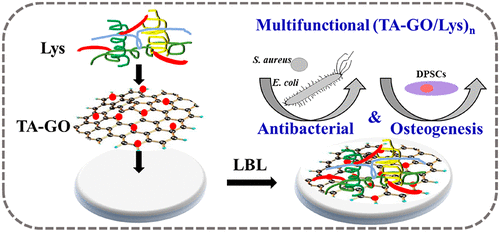当前位置:
X-MOL 学术
›
ACS Appl. Bio Mater.
›
论文详情
Our official English website, www.x-mol.net, welcomes your
feedback! (Note: you will need to create a separate account there.)
Lysozyme (Lys), Tannic Acid (TA), and Graphene Oxide (GO) Thin Coating for Antibacterial and Enhanced Osteogenesis
ACS Applied Bio Materials ( IF 4.6 ) Pub Date : 2020-01-08 , DOI: 10.1021/acsabm.9b01017 Huaqiong Li 1, 2, 3 , Chenyuan Gao 2, 3 , Lin Tang 1 , Chenou Wang 1 , Qiong Chen 1 , Qianyi Zheng 1 , Shuoshuo Yang 2, 3 , Sunren Sheng 4 , Xingjie Zan 1, 2, 3
ACS Applied Bio Materials ( IF 4.6 ) Pub Date : 2020-01-08 , DOI: 10.1021/acsabm.9b01017 Huaqiong Li 1, 2, 3 , Chenyuan Gao 2, 3 , Lin Tang 1 , Chenou Wang 1 , Qiong Chen 1 , Qianyi Zheng 1 , Shuoshuo Yang 2, 3 , Sunren Sheng 4 , Xingjie Zan 1, 2, 3
Affiliation

|
Dental implants have great potential in the global market, around $3.7 billion in 2015, which will increase to $7 billion in 2023 with an annual increase rate of 8.2%. Incorporating antibacterial and osteogenic agents into implants is helpful to make the dental implants successful, which can be endowed by coatings. In recent years, graphene oxide (GO) and its composite materials have shown advances in the biomedical field. Lysozyme (Lys) and tannic acid (TA) are naturally derived, with promising antibacterial and osteogenic properties as well. In the present study, the strong antibacterial and enhanced osteogenic multilayer coating is fabricated using the facile and controllable layer by layer (LBL) technique to integrate GO, Lys, and TA. The thickness of coating exhibited a continuous growth with the deposited process as proved from UV–vis and ellipsometry data, and the physical properties of the coating, such as wettability, roughness, and stiffness are well characterized. The coatings exhibited the synergic effect on the killing bacteria, both Gram-negative bacteria and Gram-positive bacteria represented by E. coli and S. aureus, respectively, and enhancing osteogenesis of dental pulp stem cells (hDPSCs), showing the potential application on coatings of dental implants. Thus, the strategy applied here will inspire the design and development of dual functional surfaces for the success of implanted dental surface in future.
中文翻译:

溶菌酶 (Lys)、单宁酸 (TA) 和氧化石墨烯 (GO) 薄涂层,用于抗菌和增强成骨作用
种植牙在全球市场潜力巨大,2015年约37亿美元,2023年将增至70亿美元,年增长率为8.2%。在种植体中加入抗菌剂和成骨剂有助于牙种植体的成功,这可以通过涂层来赋予。近年来,氧化石墨烯(GO)及其复合材料在生物医学领域取得了进展。溶菌酶 (Lys) 和单宁酸 (TA) 是天然来源的,具有良好的抗菌和成骨特性。在本研究中,使用简便且可控的逐层(LBL)技术将GO、Lys和TA集成在一起,制备了强抗菌和增强成骨多层涂层。从紫外-可见光和椭偏仪数据证明,涂层的厚度随着沉积过程的不断增加,并且涂层的物理性能,如润湿性、粗糙度和刚度都得到了很好的表征。涂层对杀死革兰氏阴性菌和革兰氏阳性菌均表现出协同作用分别为大肠杆菌和金黄色葡萄球菌,并增强牙髓干细胞(hDPSCs)的成骨作用,显示出在牙种植体涂层上的潜在应用。因此,这里应用的策略将激发双功能表面的设计和开发,以实现未来种植牙表面的成功。
更新日期:2020-01-09
中文翻译:

溶菌酶 (Lys)、单宁酸 (TA) 和氧化石墨烯 (GO) 薄涂层,用于抗菌和增强成骨作用
种植牙在全球市场潜力巨大,2015年约37亿美元,2023年将增至70亿美元,年增长率为8.2%。在种植体中加入抗菌剂和成骨剂有助于牙种植体的成功,这可以通过涂层来赋予。近年来,氧化石墨烯(GO)及其复合材料在生物医学领域取得了进展。溶菌酶 (Lys) 和单宁酸 (TA) 是天然来源的,具有良好的抗菌和成骨特性。在本研究中,使用简便且可控的逐层(LBL)技术将GO、Lys和TA集成在一起,制备了强抗菌和增强成骨多层涂层。从紫外-可见光和椭偏仪数据证明,涂层的厚度随着沉积过程的不断增加,并且涂层的物理性能,如润湿性、粗糙度和刚度都得到了很好的表征。涂层对杀死革兰氏阴性菌和革兰氏阳性菌均表现出协同作用分别为大肠杆菌和金黄色葡萄球菌,并增强牙髓干细胞(hDPSCs)的成骨作用,显示出在牙种植体涂层上的潜在应用。因此,这里应用的策略将激发双功能表面的设计和开发,以实现未来种植牙表面的成功。









































 京公网安备 11010802027423号
京公网安备 11010802027423号